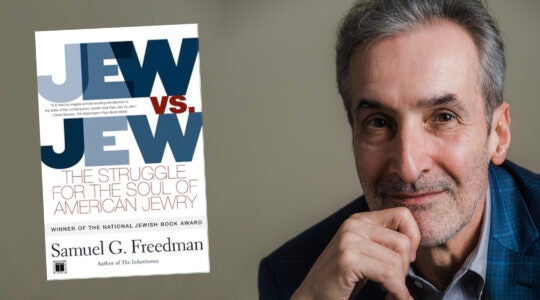Many years ago, the American Jewish activist Leonard Fein wrote that there are two kinds of Jews in the world: There is the kind of Jew who detests war and violence, who believes that fighting is not the Jewish Way. And then there is the kind of Jew who is convinced that we have been passive long enough, who is convinced that it is time to strike back at our enemies, to reject once and for all the role of victim, who will willingly accept that Jews cannot afford to depend on favors, that we must be tough and strong.
And the trouble is, Fein added, that most Jews are both kinds of Jew.
As I came of age, I felt that tug embodied most in the characters of Philip Roth and Leon Uris. The two books that were most formative of my polarized Jewish psyche were, hands down, “Exodus” and “Goodbye Columbus.” I marveled at the pride of Ari Ben Canaan and his ability to stare down an anti-Semitic British officer who could “spot a Jew a mile away.” At the same time, I felt the unease of Jews just finding themselves in America, feeling the tug of both maternal and Holocaust guilt while wallowing in passivity and helplessness.
Roth’s work profoundly influenced me. It would probably have given him a perverse thrill to know that his fiction had a lot to do with a young Jew’s decision to become a rabbi. I would venture to guess that there is an entire generation of Roth-ian rabbis, which is a pretty big deal considering how he was so excoriated by the rabbinic establishment for his early works, including “Goodbye Columbus” and “Portnoy’s Complaint.”
While Ari Ben Canaan was who we wanted to be, Roth’s characters represented who we were, or at least who we perceived ourselves to be. And in their own way, those characters were equally heroic.
Roth was able to call out the materialism and superficiality of post-war American Jewry. In his stories, the insecurity of Jews was a source of weakness and shame, but their marginality was also a source of strength. It was those characters who had not “made it,” who never fit in, who could best point out the hypocrisy that was so rife in their communities.
I recently picked up a new collection of Roth’s nonfiction essays, called “Why Write,” the final work published in his lifetime.My favorite story of the “Goodbye Columbus” collection, is the last one, “The Conversion of the Jews,” featuring Ozzie, a Hebrew school student who rebelled against an abusive teacher, who ultimately realized a degree of power over his tormentors when he ran to the roof and threatened to jump. I was a Hebrew school student myself when I first read it — actually, it was read to my bunk at bedtime at Camp Ramah. My counselors were fully immersed in the counter culture, and through them, Roth’s work was weaponized as a means of attacking the Jewish establishment. Combined with the music of Bob Dylan and Simon and Garfunkel, and films like “The Graduate,” Roth enabled us to fight a very different battle from the one being waged by our Ben Canaan cousins in Israel at that same time, but no less revolutionary.
I was taken by an essay called “New Jewish Stereotypes,” originally delivered at a symposium in Chicago in 1961, at a time when the film version of “Exodus” had just been released, and when Roth was enduring constant barbs from the Jewish establishment about “Goodbye Columbus.”
Uris had criticized Roth indirectly in a New York Post interview, saying, “There’s a whole school of American Jewish writers who spend their time damning their fathers, hating their mothers, wringing their hands, and wondering why they were born. This isn’t art or literature. It’s psychiatry…. I wrote ‘Exodus’ because I was sick of apologizing. (I discovered that) we Jews are not what we have been portrayed to be. In truth, we have been fighters.”
In this essay, Roth responds: “However you slice it, there does not seem to be any doubt that the image of the Jew as patriot, warrior, and battle-scarred belligerent is rather satisfying to a large segment of the American public.” He then goes on to mock the facile transition of the image of the Jew from victim to warrior and noted that the new image was so off base that official version of the theme song for “Exodus” had to be sung not by Jewish singers Moshe Oysher or Eddie Fisher, but by the ultimate WASP, Pat Boone.
Roth suggests that “Exodus’s” inflated popularity stems from the fact that both American Jews and Americans in general were desperate to change the subject following the Holocaust. “The Jew is no longer looking out from the wings of the unending violence of our age, nor is he any longer its favorite victim; now he is a participant.” He adds, “Mr. Uris’s discovery that Jews are fighters fills him with pride; it fills any number of his Jewish readers with pride, and his Gentile readers less perhaps with pride than with relief.”
Roth then compares Uris to a young author at the time named Elie Wiesel, whose work “Dawn,” a sequel to “Night,” takes place in pre-state Palestine and depicts the true face of this new Jewish warrior; not the idealized Ari Ben Canaan, but one who has been profoundly wounded in Buchenwald and Auschwitz, who has seen and suffered so much.
Uris’s depiction of fighter Jews was a rejection of the “ghetto Jew” so often mocked by early Zionists and, which, to a degree, is still the stereotyped depiction of American Jews by many contemporary Israelis. When they look at the diaspora, they are looking at it through disdain, as did Uris.
That disdain might partially explain the Israeli right’s infatuation with American evangelicals, who can be compared to the “shiksa goddesses” of Roth’s works. The guest list at the recent American embassy relocation indicates that three-quarters of American Jews — those who voted Democratic in 2016 — were left at the altar and not invited to the reception, while Prime Minister Netanyahu seems to pine for acceptance to the exclusive, very non-Jewish country club that would never have let Alexander Portnoy in.
I bet Pat Boone was invited.
The Roth-Uris battle still resonates, decades later. Who are we? The fighter or the kvetcher? The noble or the nebbish? The ideal or the real?
Or are we both types of Jew? Proud, but complicated. Or complicated, but proud of it.
We are Ari Ben Portnoy. So don’t mess with us.
We make enough of a mess of things all by ourselves.
Rabbi Joshua Hammerman is being honored this month for more than 30 years of service to Temple Beth El in Stamford, CT.
The New York Jewish Week brings you the stories behind the headlines, keeping you connected to Jewish life in New York. Help sustain the reporting you trust by donating today.




